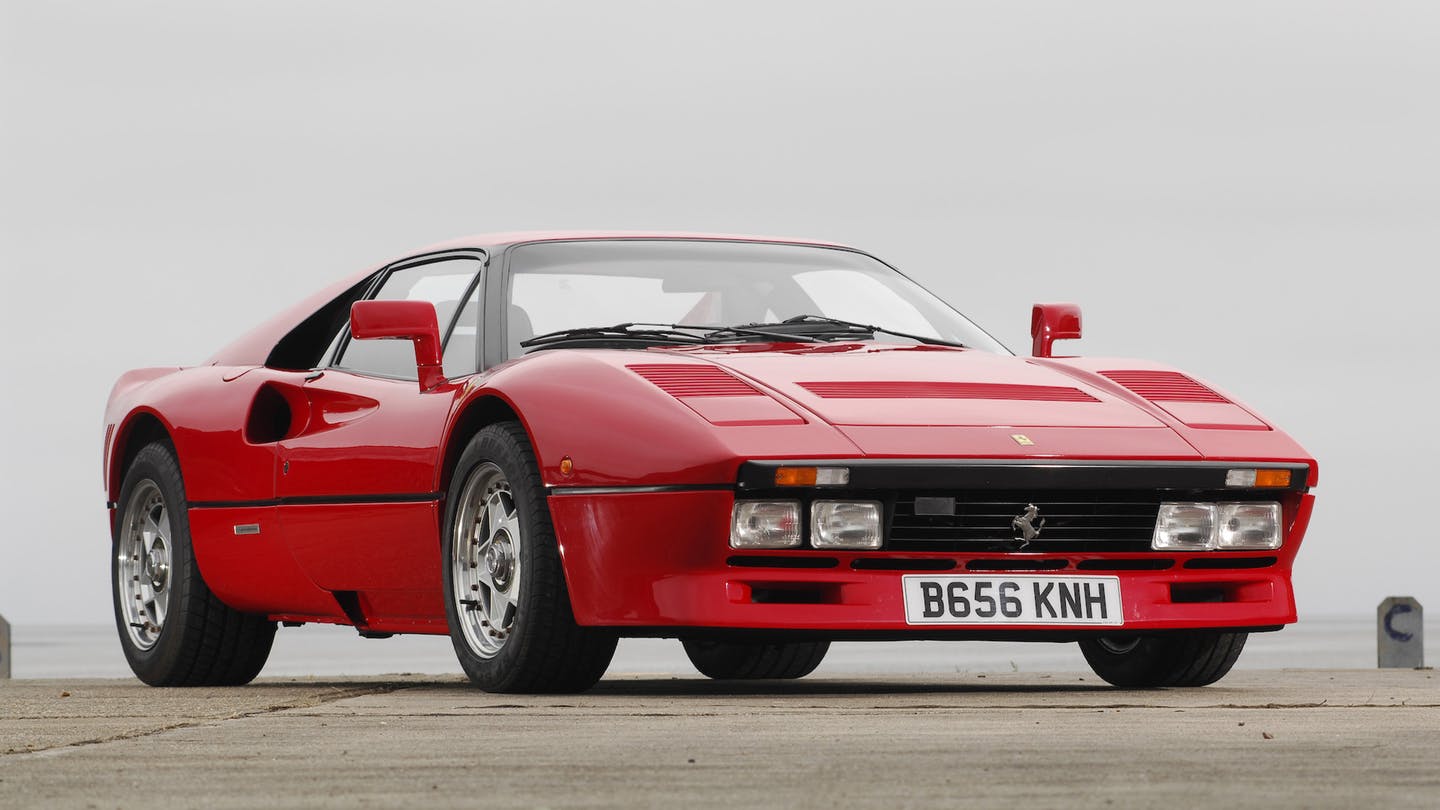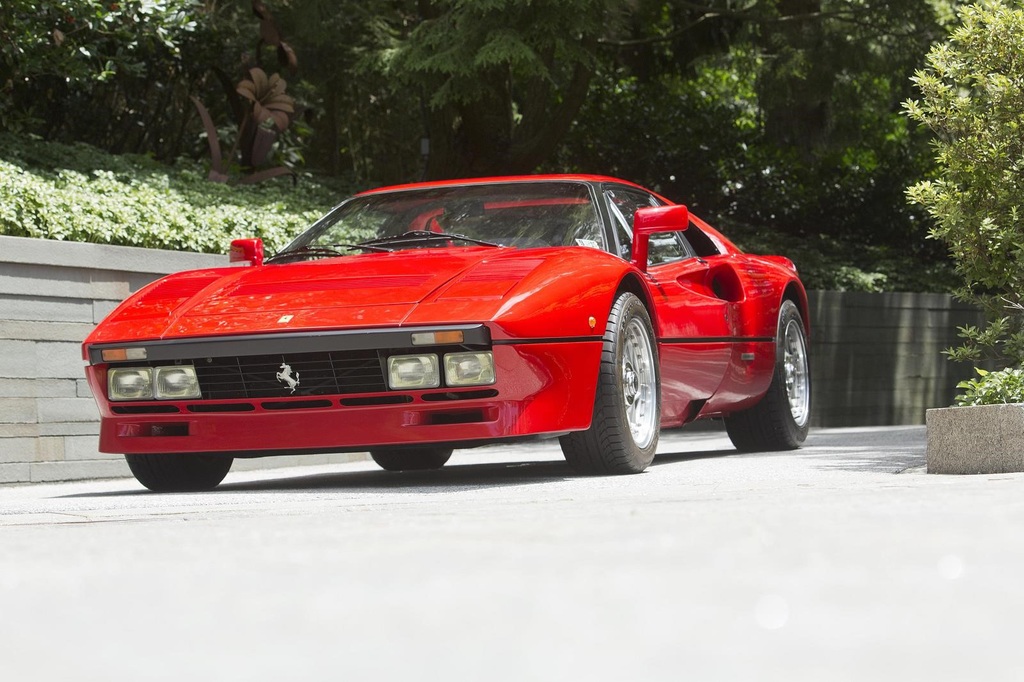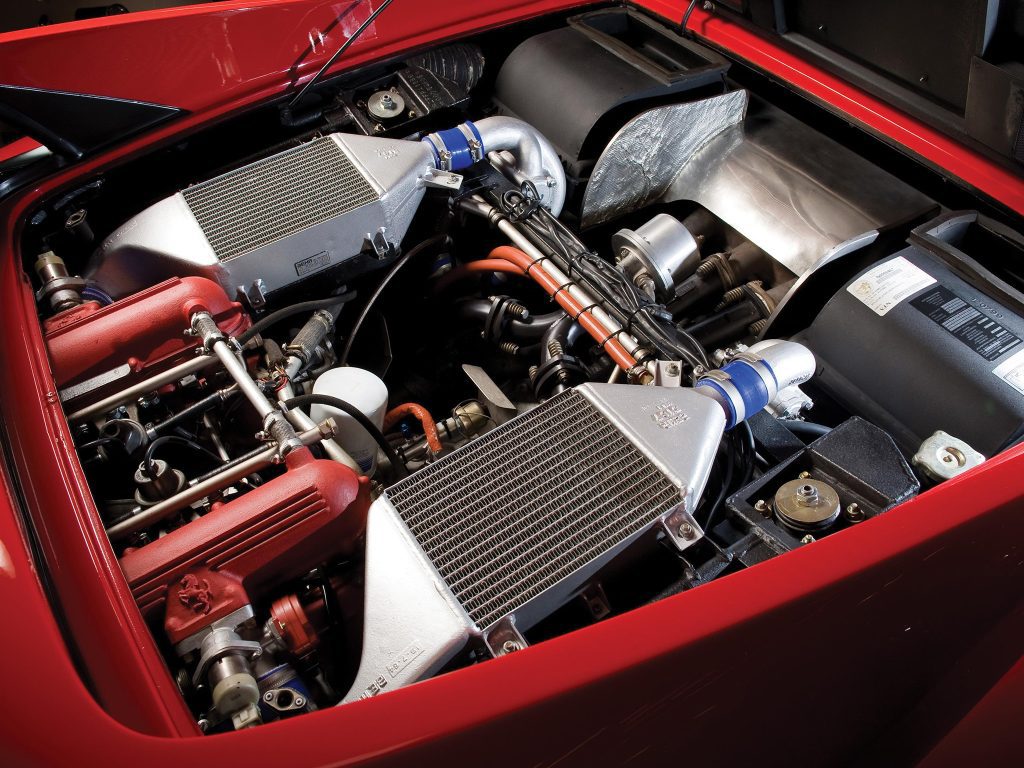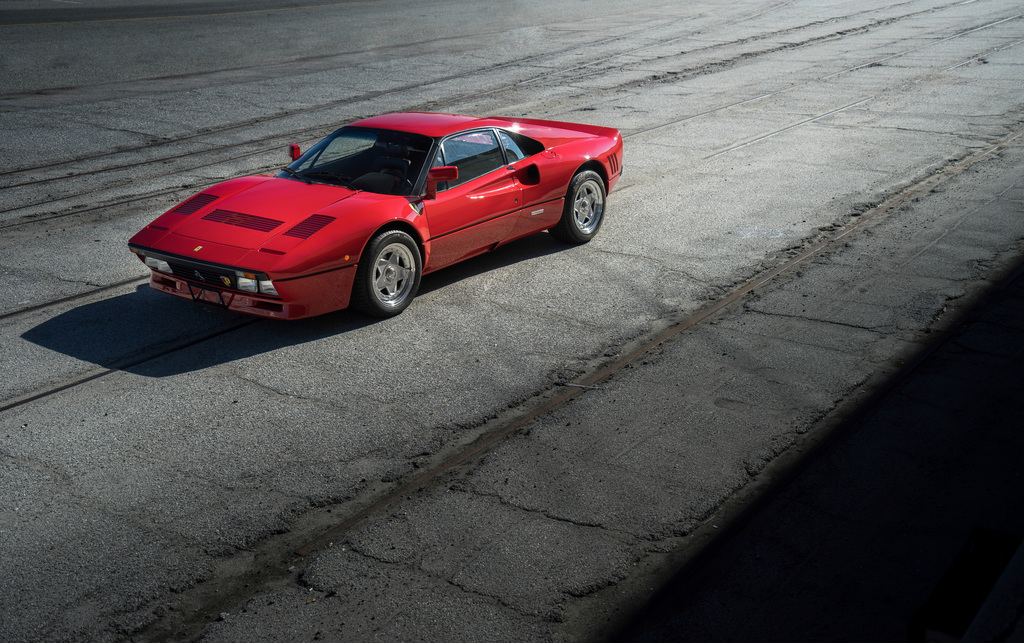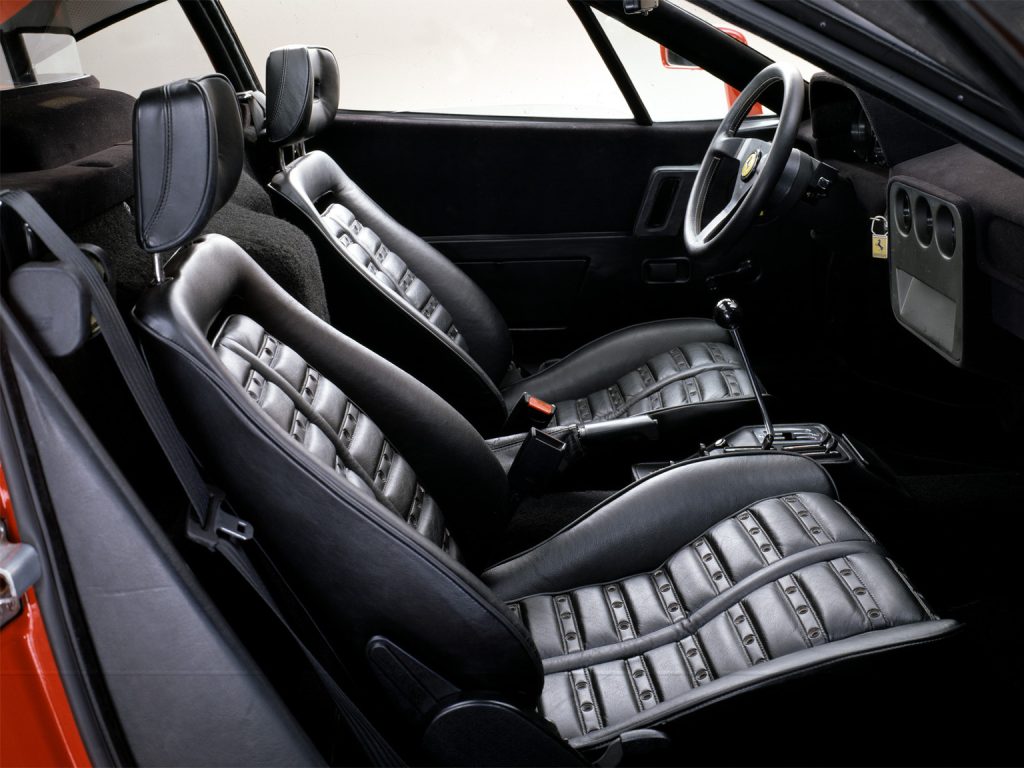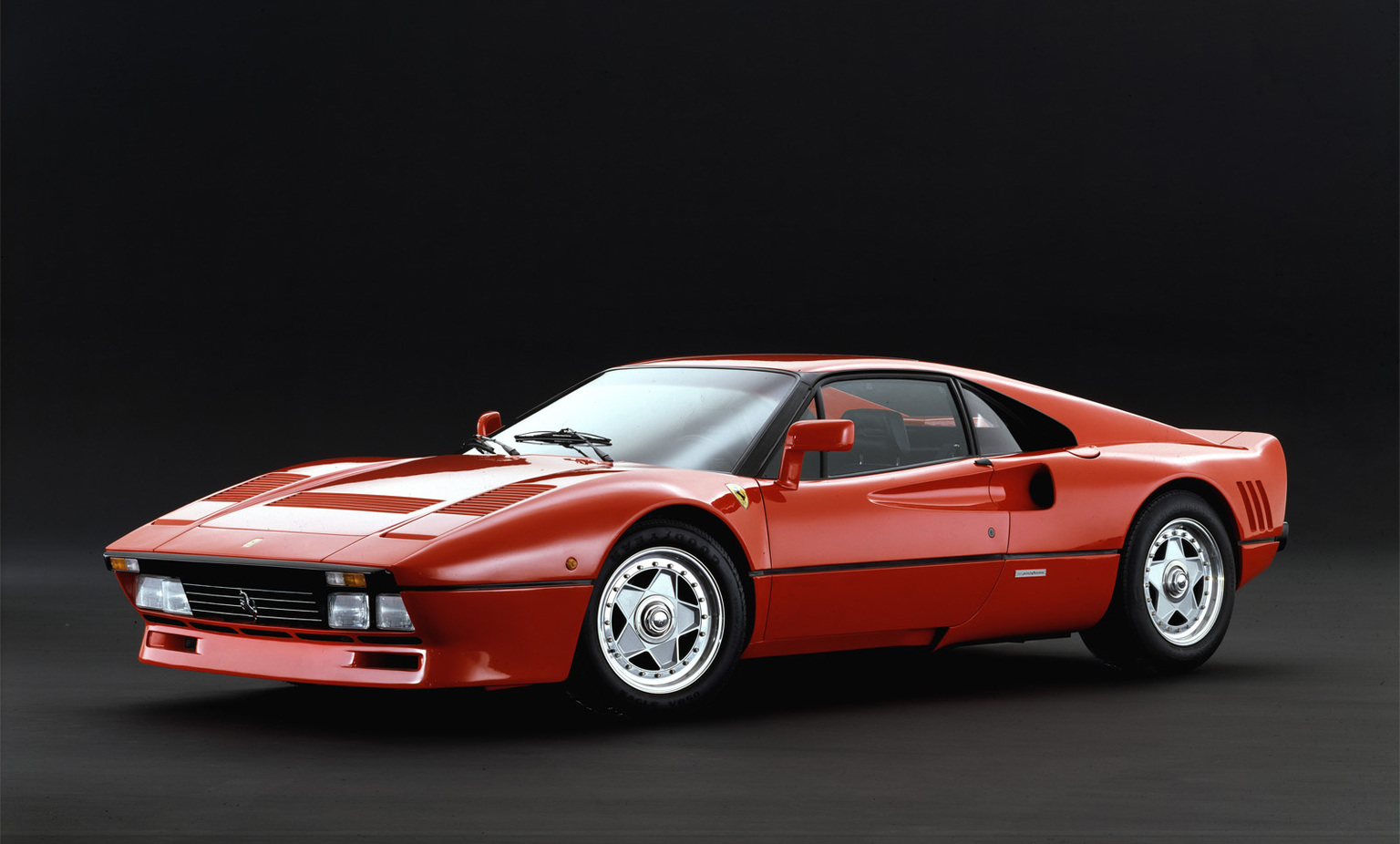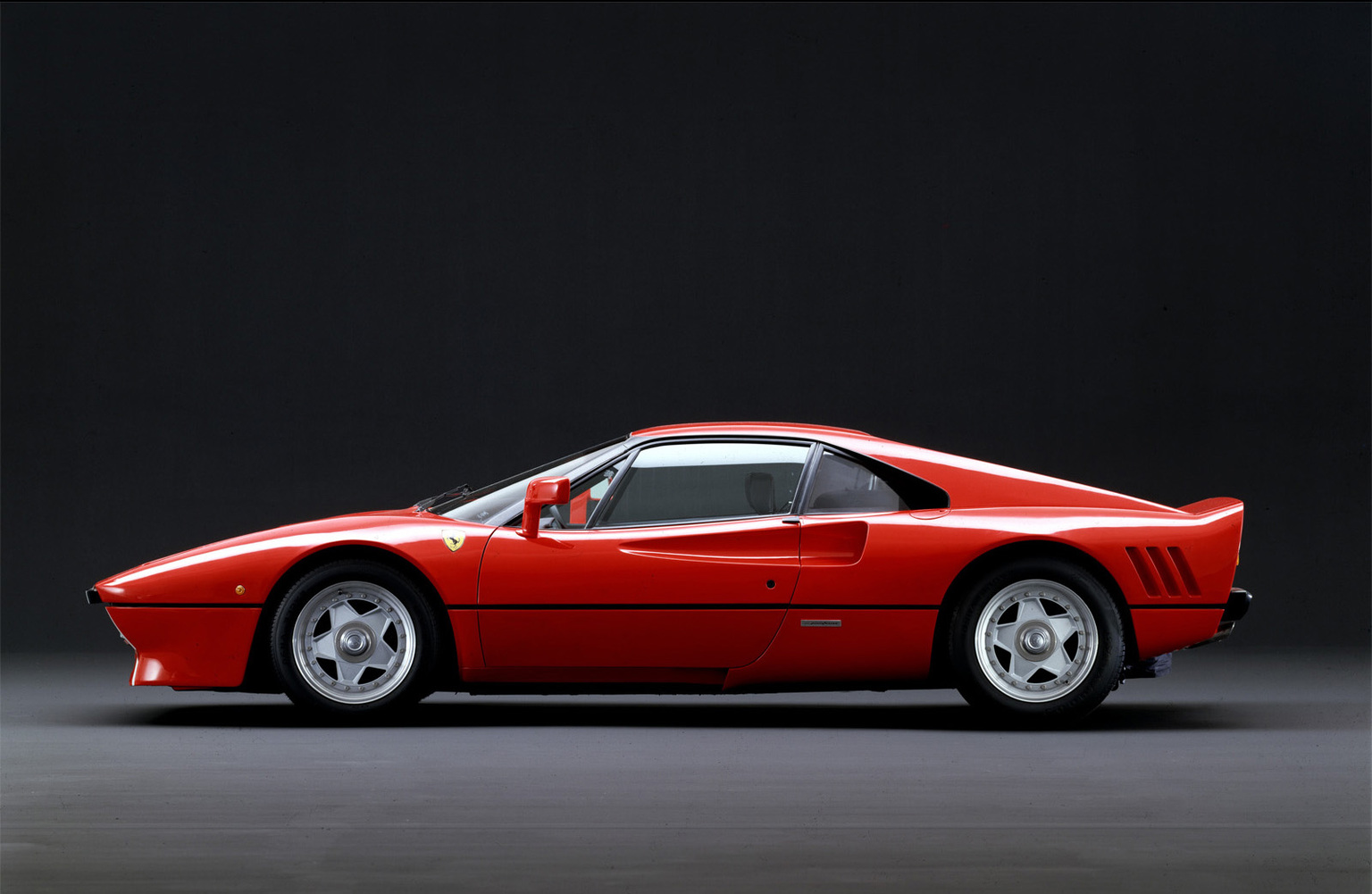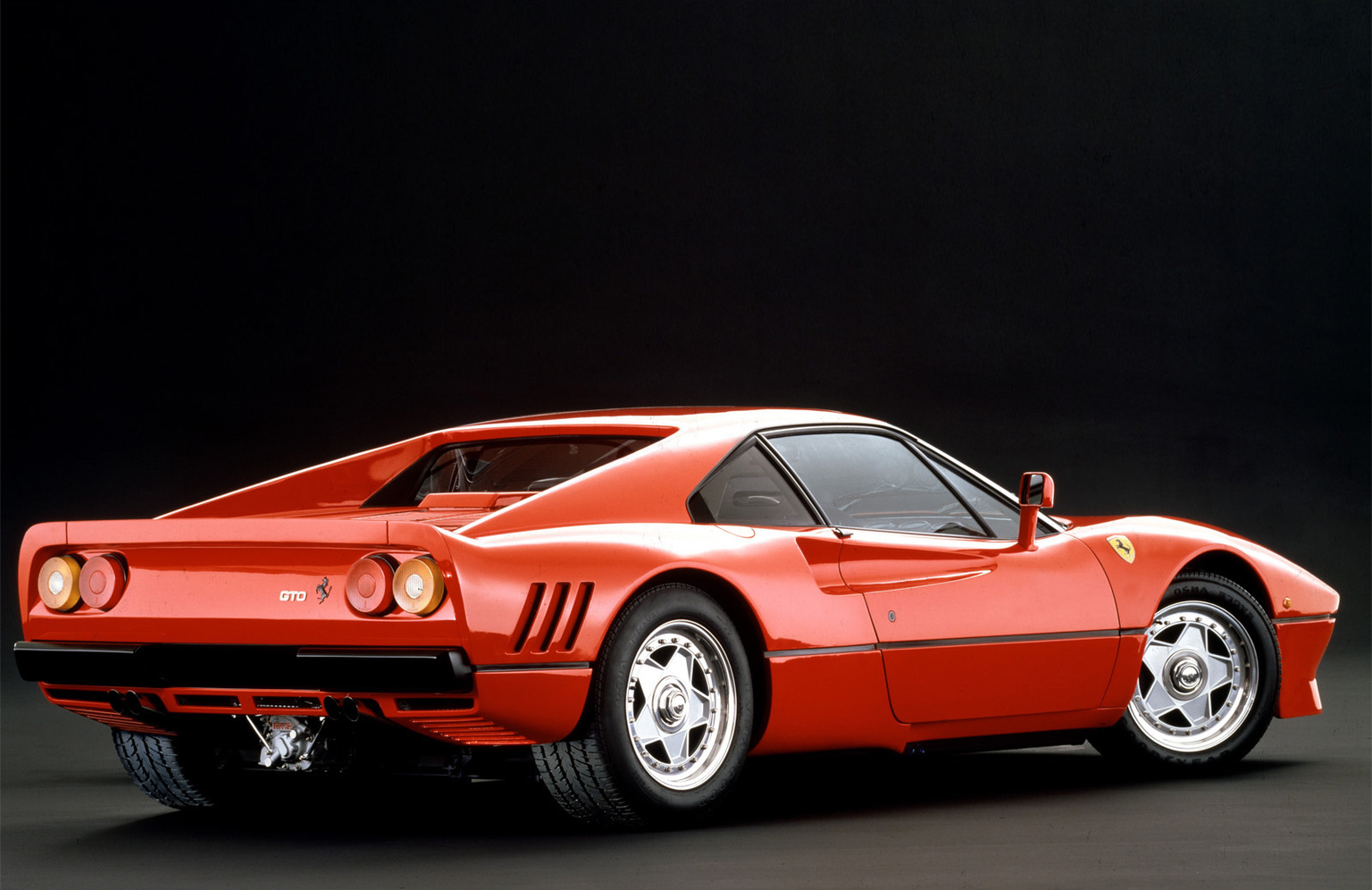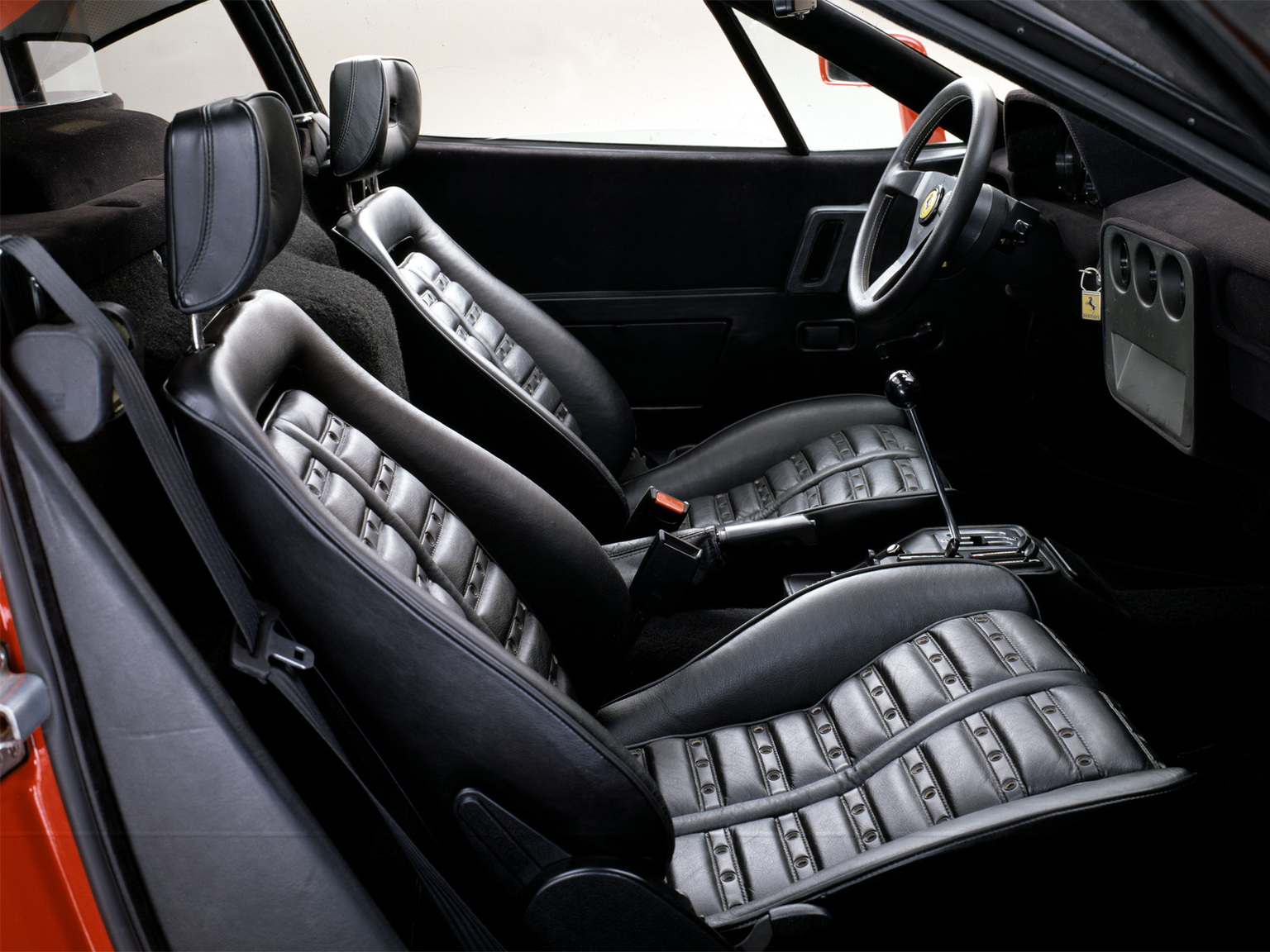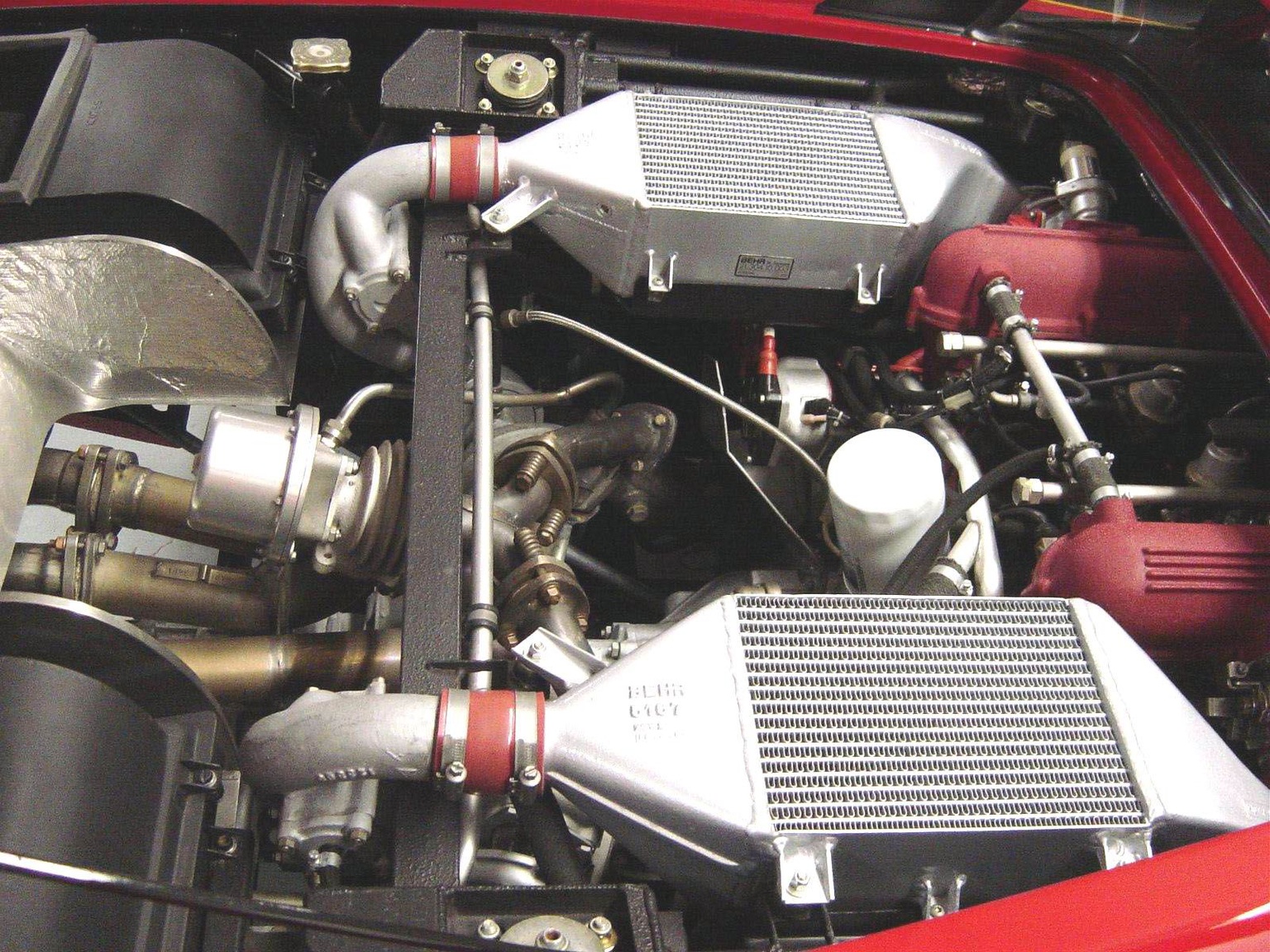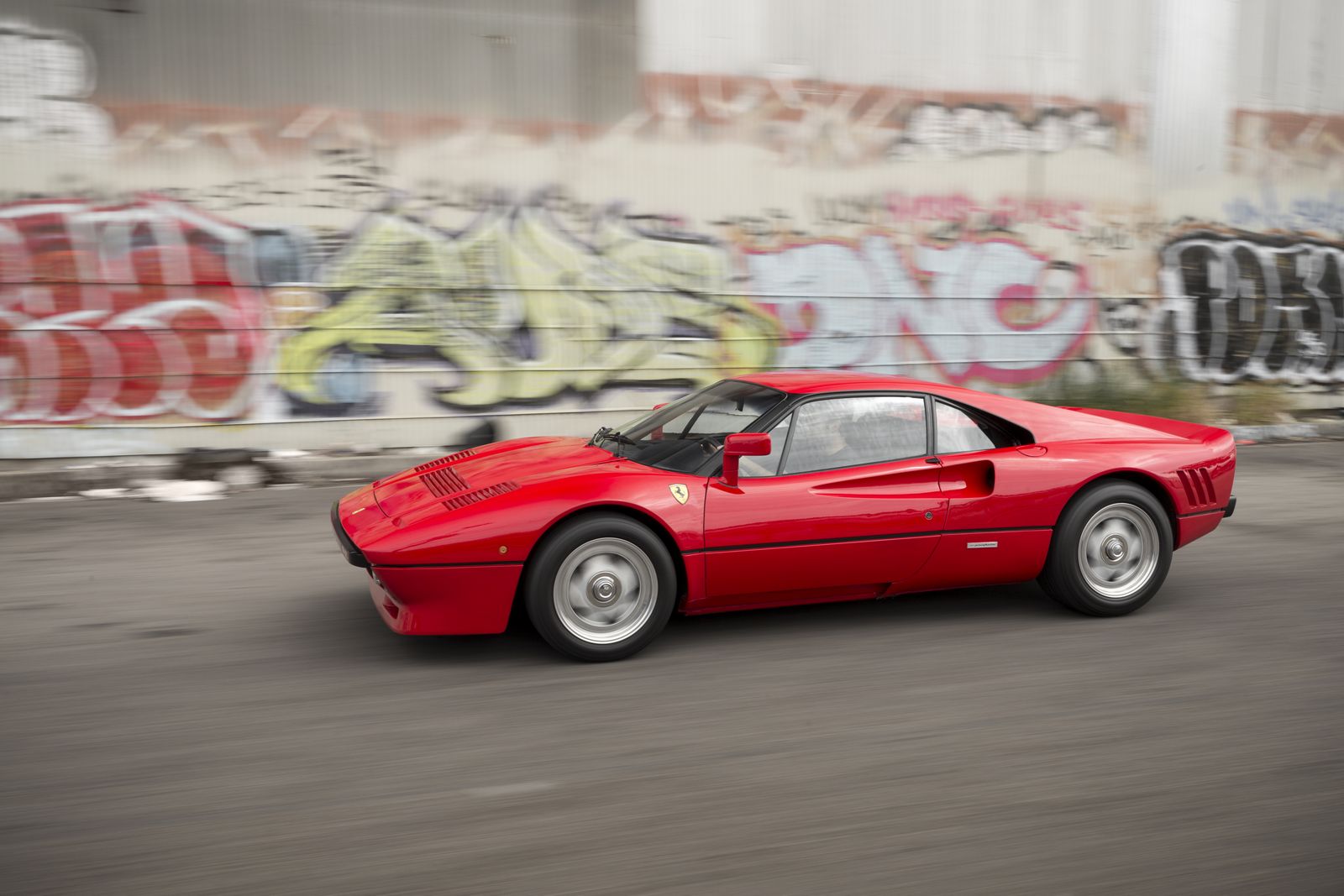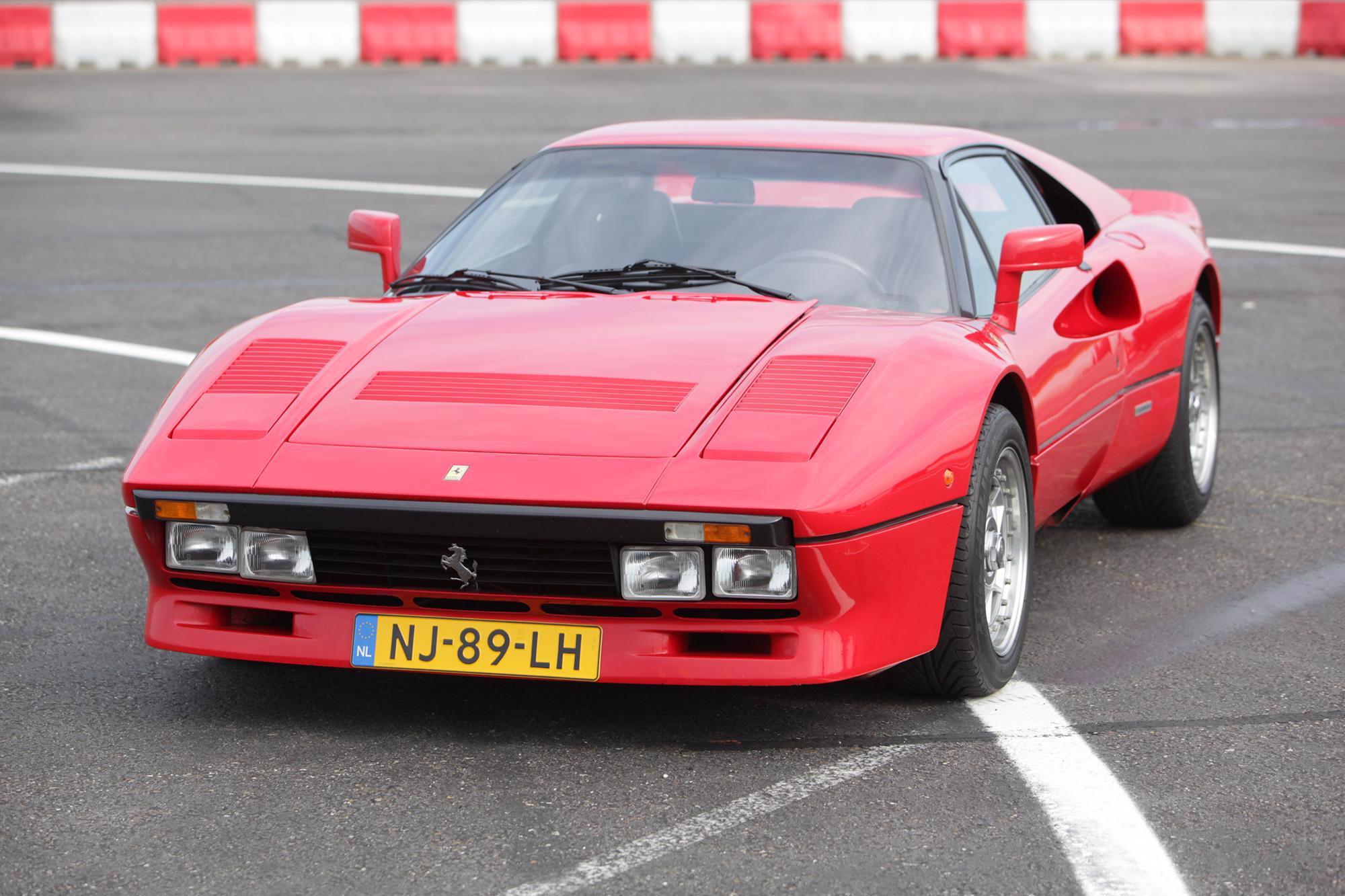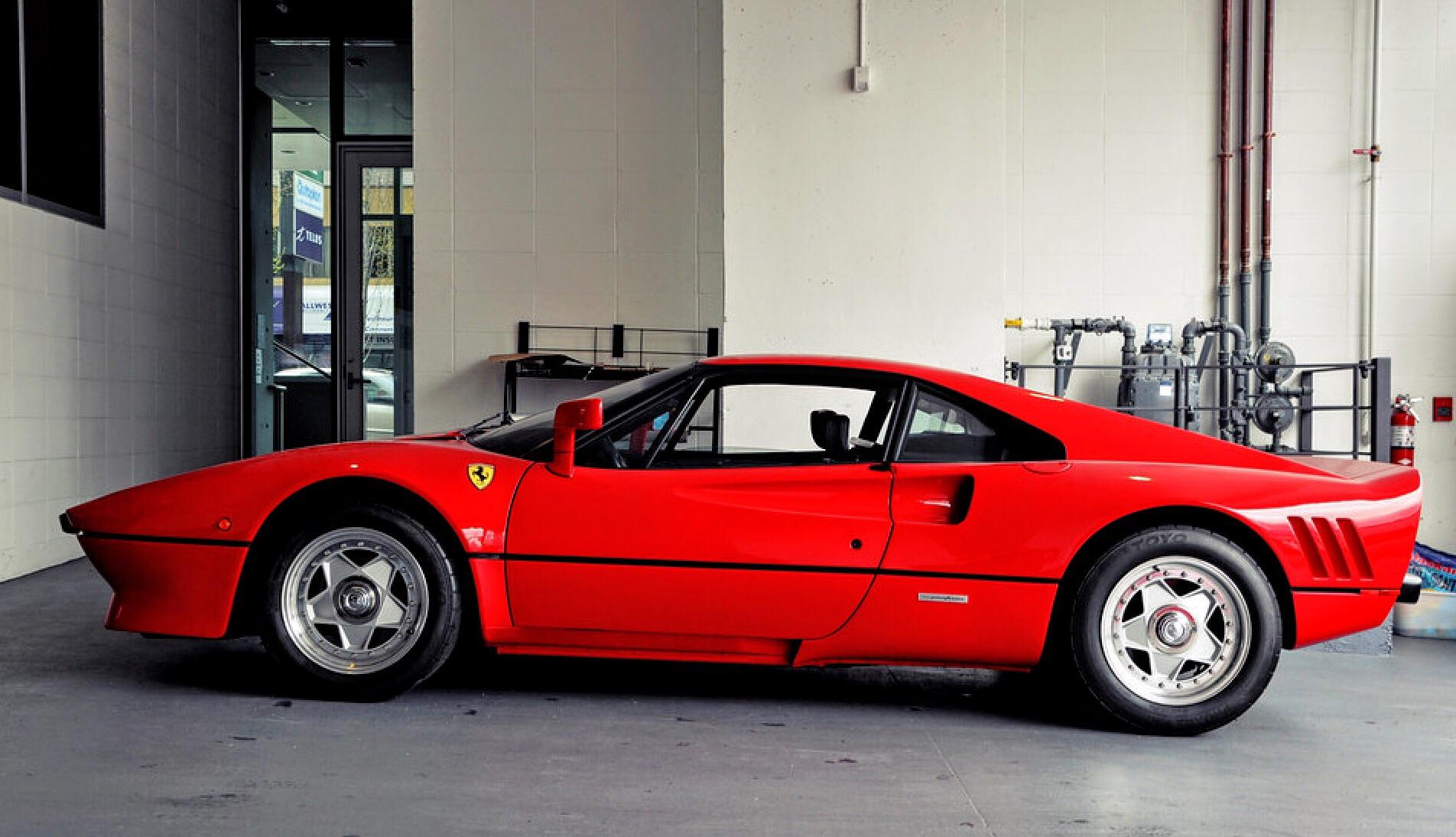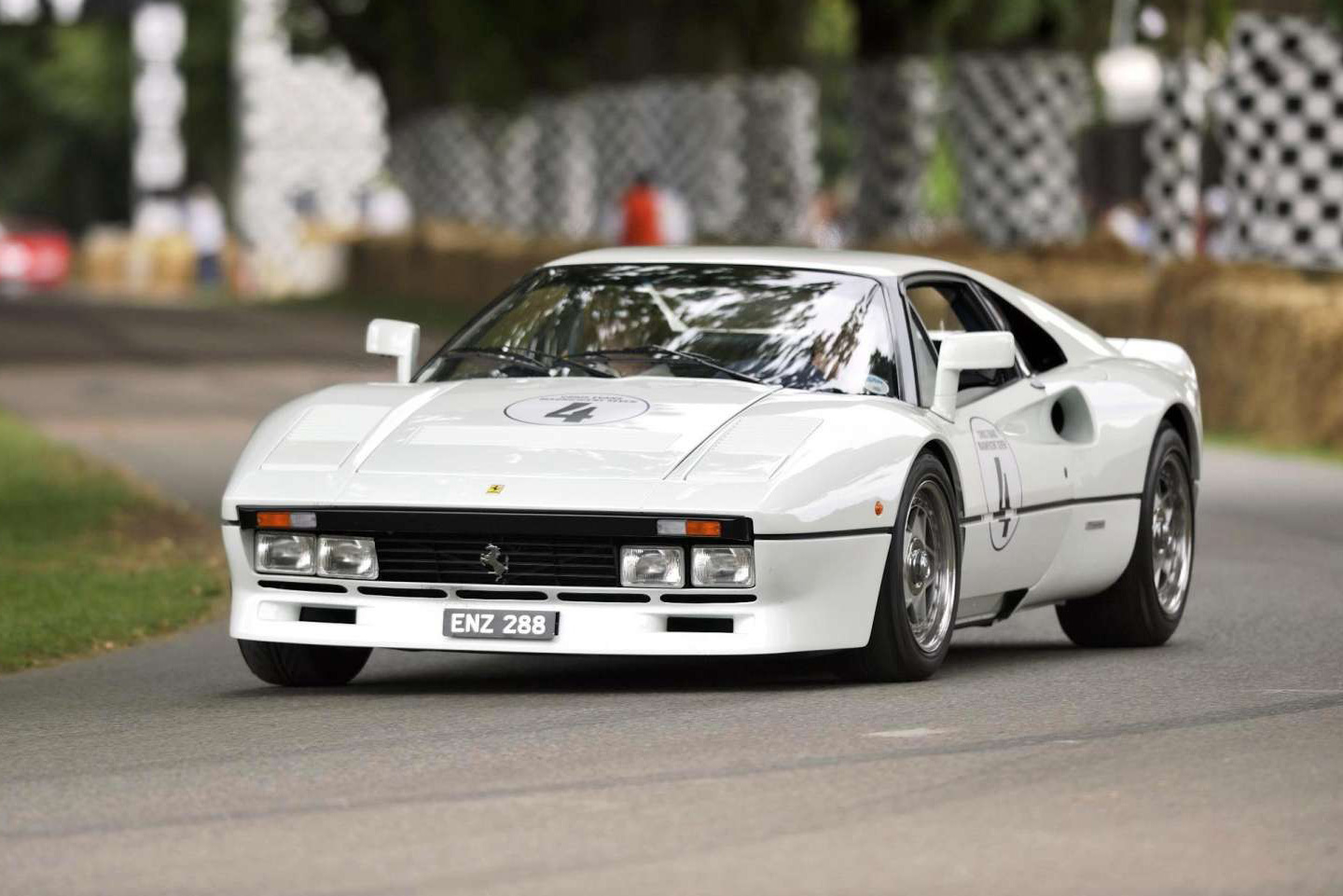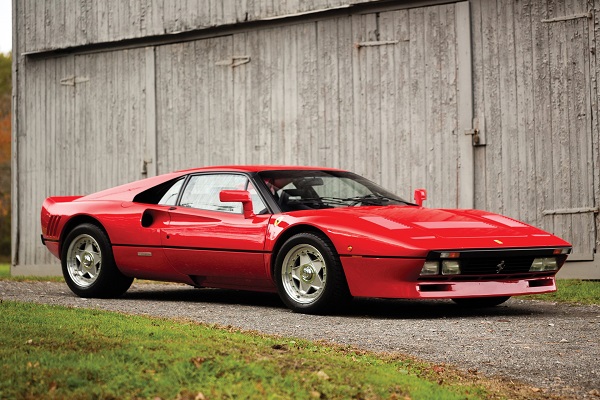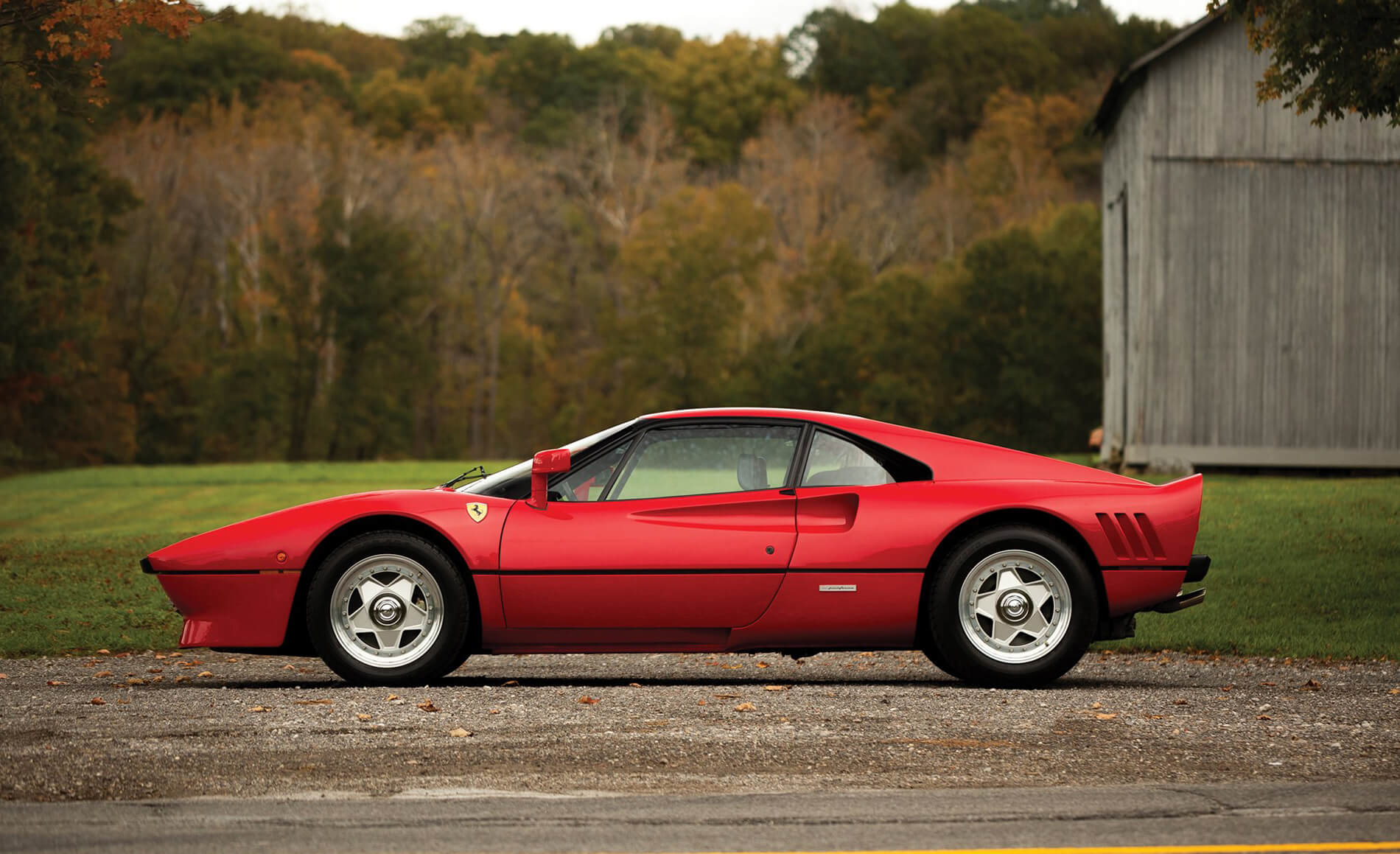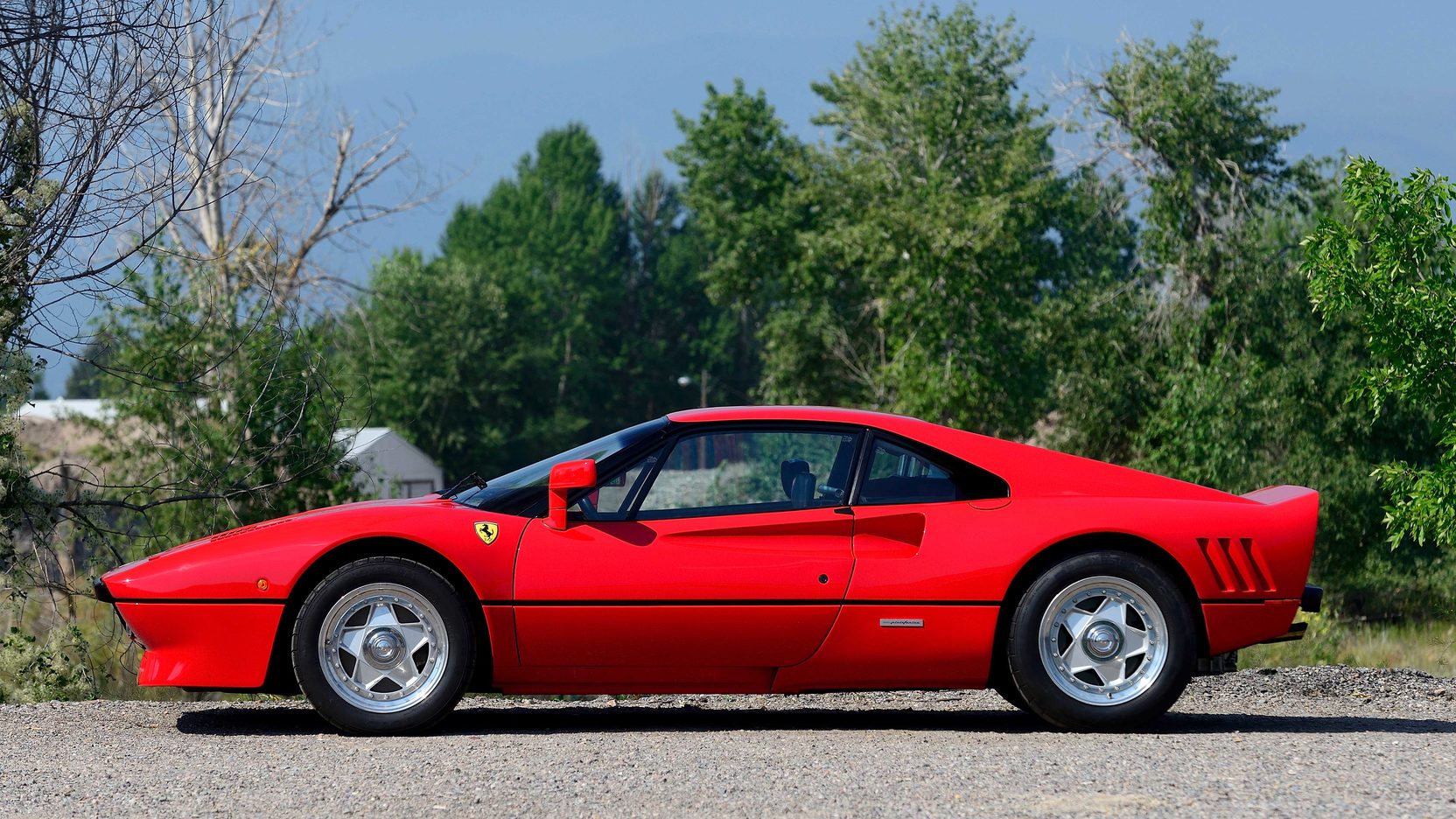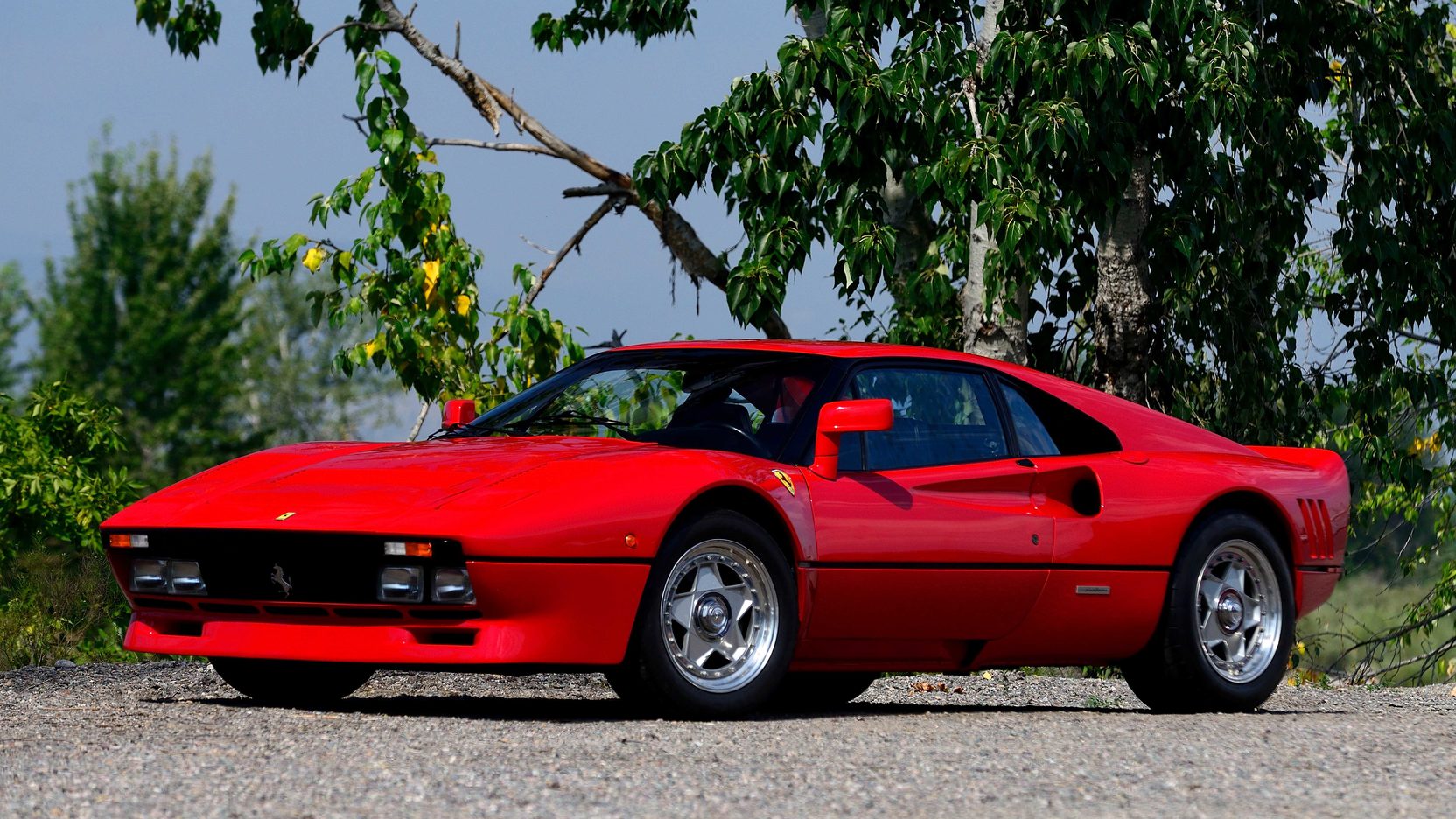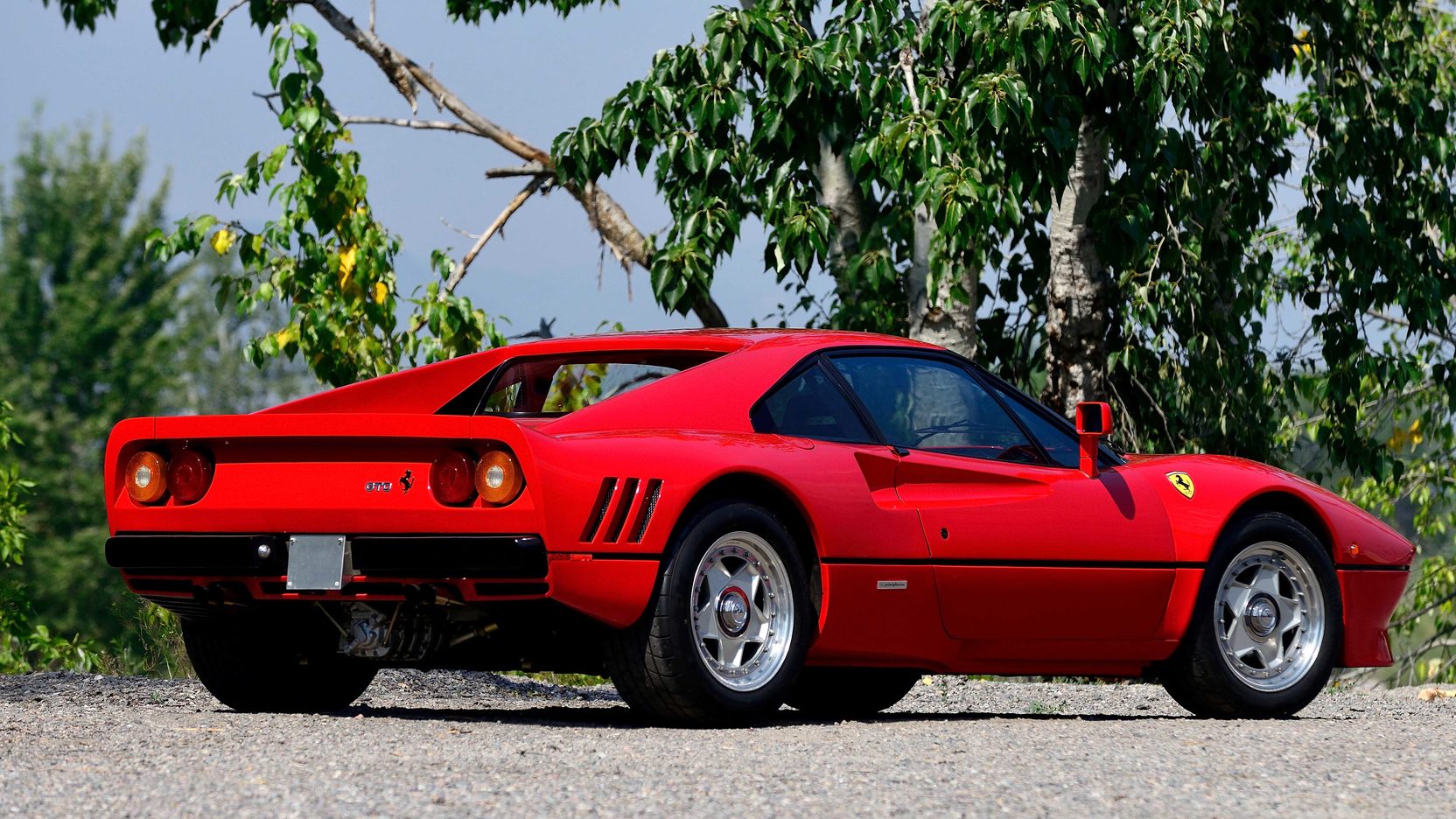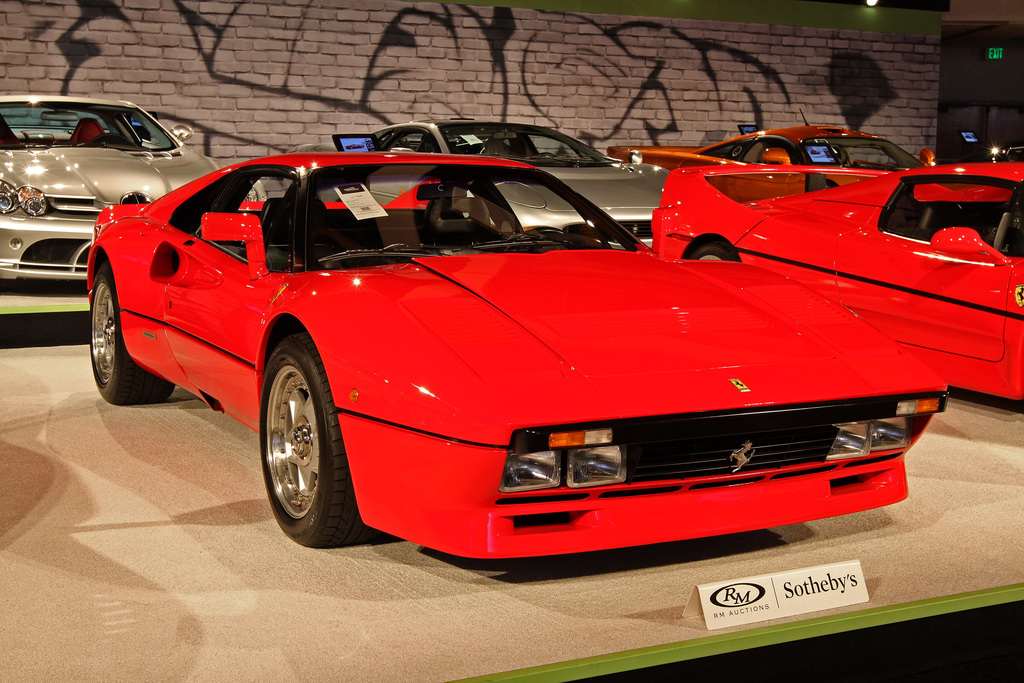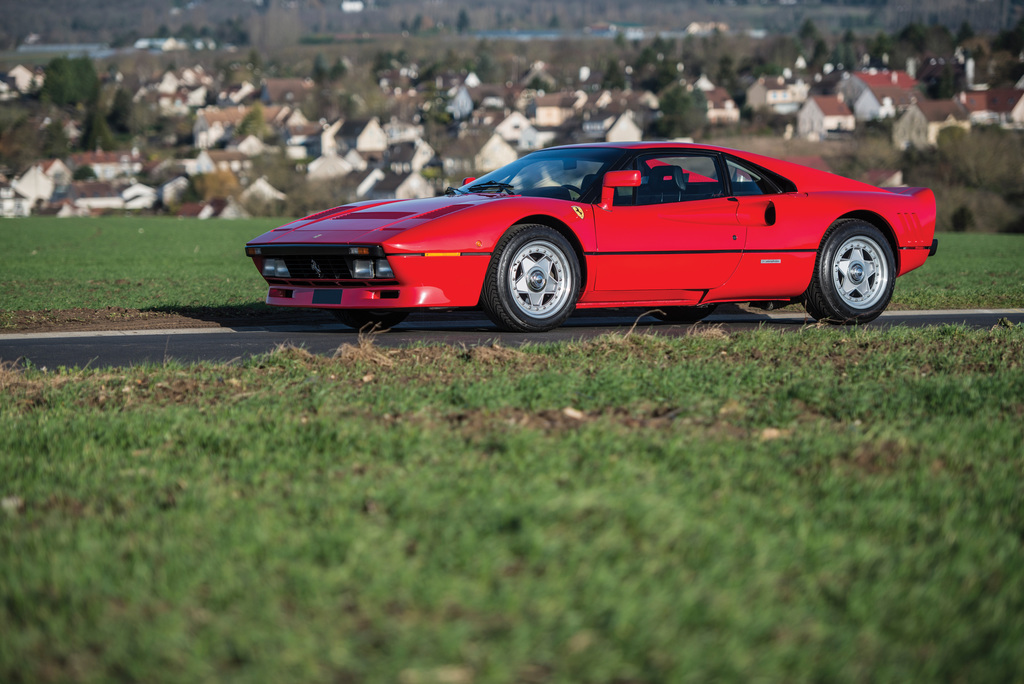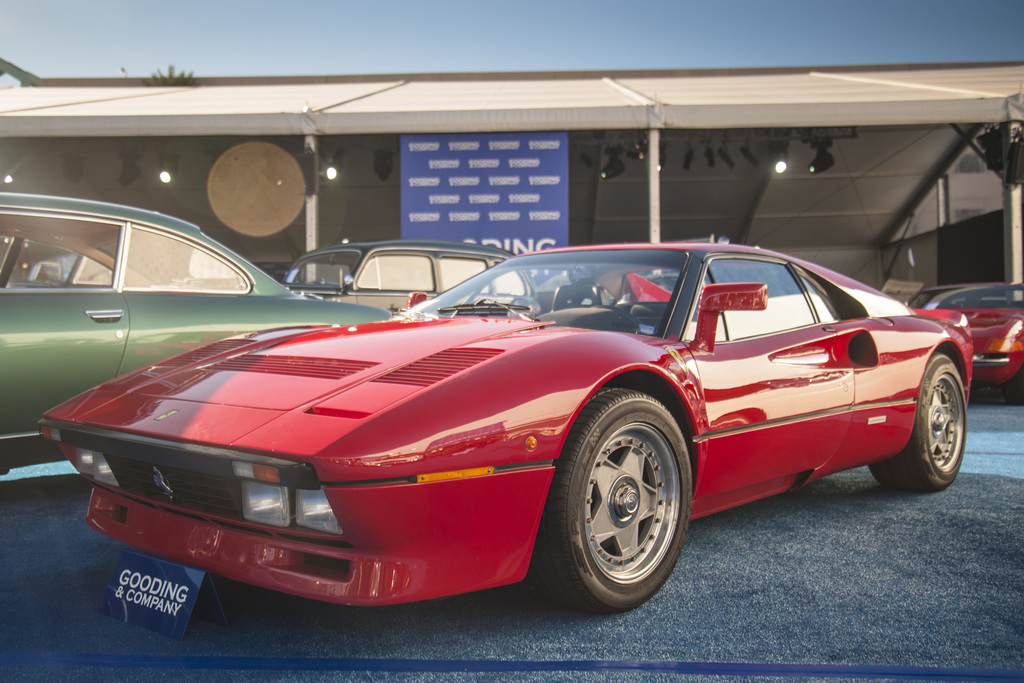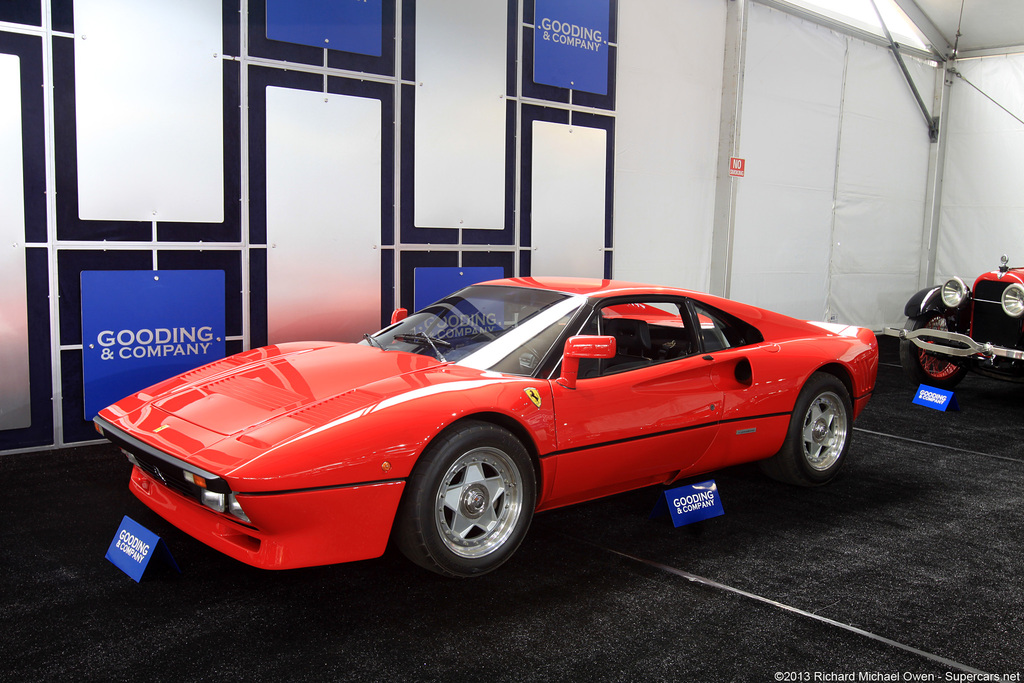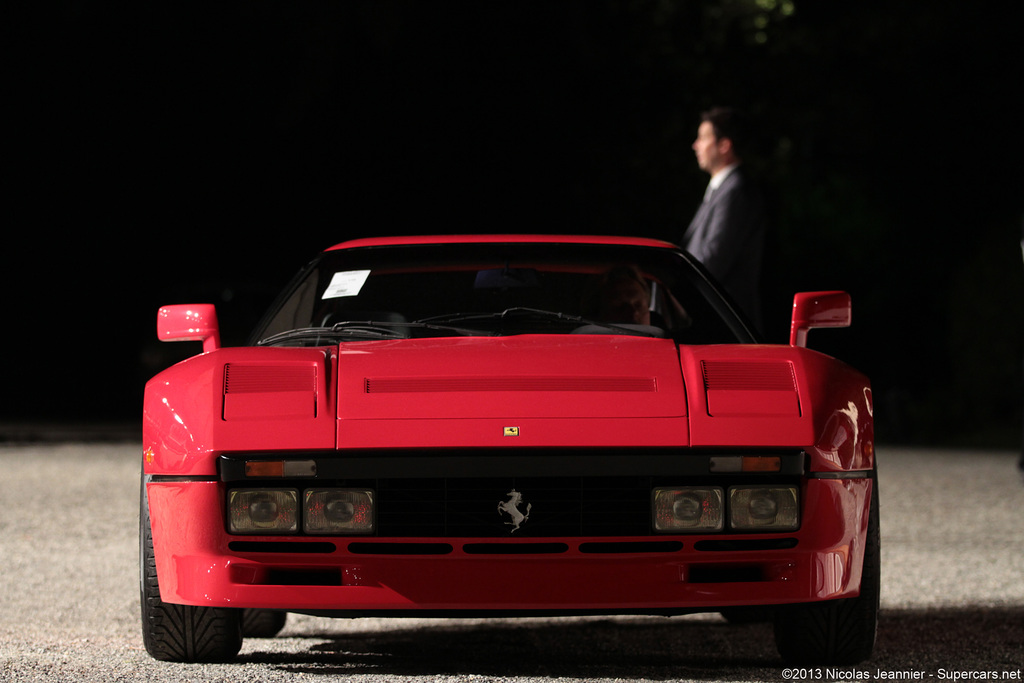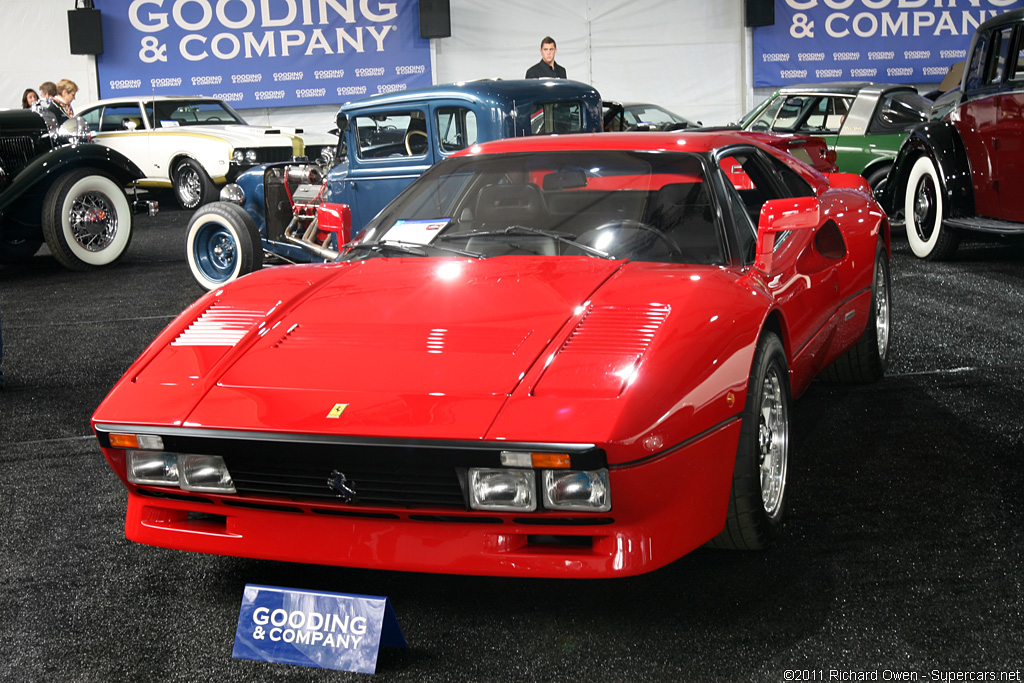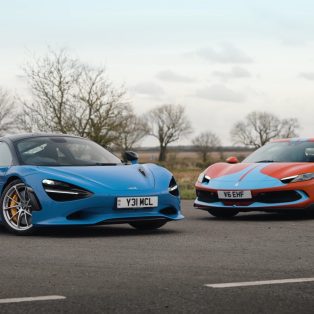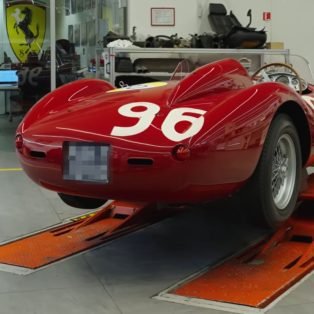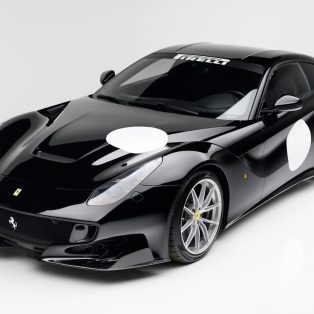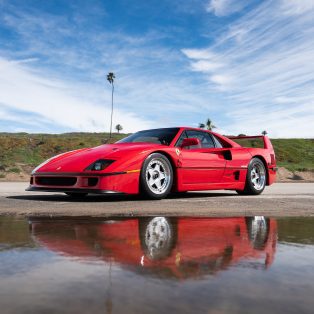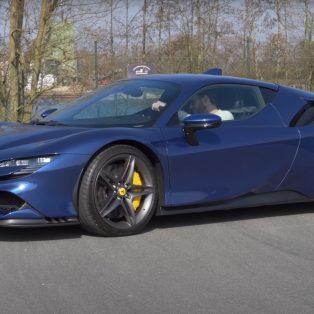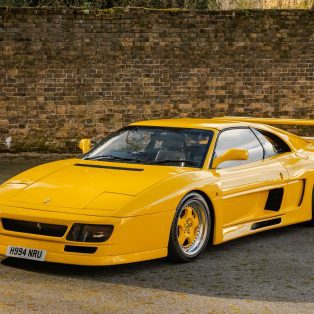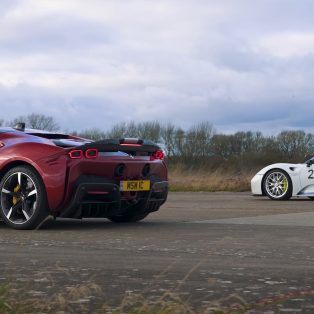Ferrari 288 GTO
Engine: 2,855 cc, twin-turbocharged V8
Transmission: Five-speed manual, rear drive
Power: 394 bhp @ 7,000 rpm
Torque: 366 lb/ft @ 3,800 rpm
Weight (Dry): 1161 kg (2560 lbs)
Power to Weight: 350bhp/ton
0-60 mph:4.8 sec
Top Speed: 189 mph
Introduction
In 1984 Ferrari produced a street-legal car that paradoxically and magically combined the most sublime beauty with a very raw level of performance. Developed beside the Testarossa, the car also bore a name writ large in Ferrari history: GTO – Gran Turismo Omologata. The 1962-64 250 GTO is perhaps the most desired of all Ferraris, and amongst the rarest. It was a notably successful racing car, homologated for GT sports car racing in the golden era. The 1984 GTO was a 2.8 liter twin turbocharged V8 with a power output of 400bhp (140bhp / liter) enough to reach 60mph in 5s or less, and with a conservatively rated top speed of 189mph.
Like its forebear, the GTO’s real home was to be the public roads designated as FISA Group B racing tracks, for which series it was necessary to homologate 200 customer cars. In fact Ferrari built 272 modern GTOs, and because of the demise of the no-holds barred Group B supercar series almost all became road cars. With their blend of serene control and dynamic violence they have been called the most exciting automobiles ever created.
It is worth noting that no GTOs were imported into North America by Ferrari, and prospective buyers should therefore purchase through an authorized Ferrari dealer to ensure the car is correctly Federalized.
Group B Racing
Group B was a set of regulations introduced in 1982 for competition vehicles in sportscar racing and rallying regulated by the Fédération Internationale de l’Automobile (FIA). Group B had few restrictions on technology, design and the number of cars required for homologation to compete—200, less than other series. Weight was kept as low as possible, high-tech materials were permitted, and there were no restrictions on boost. Group B was initially a very successful. But the cost of competing quickly rose and the performance of the cars proved too much resulting in a series of fatal crashes. As a consequence Group B was canceled at the end of 1986.
The formula was simple. Ferrari and a few other manufacturers in Group B took a regular model, added a boatload more power and grip, but styled their cars so that they still looked like regular models. For most manufacturers selling the 200 cars they’d built to qualify for Group B
homologation difficult but Ferrari had no issues with the 288 GTO, having sold all 200 before production even began. Despite the race series ending, 272 cars were built in a three-year run.
Design
The GTO’s styling is at first glance an evolution of Pininfarina’s twin 1970s mid-engined masterworks: the Berlinetta Boxer and the 308. It was in fact a very different car, sharing not even the respective dimensions of these pure street machines. Most notably it was shorter, with a longer wheelbase, and considerably wider – the traits of a racing car. Visually similar to the 308, the GTO enjoys a subtly cleaner and more aggressive design. It is somehow smoother, its lines more taut and muscular as the bodywork sought to cover the chassis and cabin without excess fuss.
Echoing the 250 GTO, the 288 had sectionally semicircular nacelles feeding air to the engine compartment, and angled fender gill-slits and hood louvers for exhausting the air. The GTO, however, had its compact V8 situated longitudinally behind the cabin, and its transaxle was clearly visible to those behind the car. Amongst the most noticeable styling details were the extremely deep front air dam beneath massive auxiliary lights suitable for illuminating a dusty, rainy, or dark race course, high-mounted side mirrors to give the driver a clear view over and around the large wheel blisters, and a highly aggressive kamm tail suggestive of stability at extremely high speed. These visual cues were all accurate to the car’s purpose and capability. As interesting was the almost complete lack of brightwork: even the cavallino between the tail lights was black. The GTO required nothing extra to be noticed, although like all racing Ferraris it carried the Scuderia Ferrari enamel badges on its flanks; visual subtlety was a hallmark.
The GTO’s aerodynamics were designed to be in street-legal conformity with the homologation regulations. As such, it is a car designed for stability up to its terminal velocity, although it lacks the sophisticated undertray design and aerodynamic refinement of later Ferraris.
Structure
Most of the bodywork on the 288 GTO was bespoke and was advanced for its time, being comprised principally of fiberglass and composites. The goal was lightness with strength derived from the chassis and subframes: contemporary racing design. Compressed fiberglass formed the floor pan, and most body panels. In some places, such as the engine cover, aluminum was used to augment other materials. In some places Kevlar and Nomex were employed for their respective properties. The Engine compartment was largely enclosed by an aluminum honeycomb with a Kevlar skin, and by a Kevlar and Nomex combination – heat resistant, fire retardant, strong, and light. The substructure was a high-tensile tubular steel space frame.
The GTO tubular chassis was formed of large-oval section steel welded to square- and rectangular-section tubes as warranted. The chassis was a series of subframes, each formed to its purpose and attached to the central section around the cabin. The entire rear subframe, containing the rear suspension and drivetrain, could be dropped from the car for quicker maintenance, another competition feature. Occupants were specially protected by a full roll hoop invisibly contained within the roof and B-pillars. Rigid and strong but light, the GTO’s chassis was the perfect platform for road and track, capable of handling with aplomb the vast amount of torque and power which the stock or racing drivetrain would put through it.
Through the slats in the engine cover you can see the silver-painted Behr intercoolers and, when you lift the cover, you can see how far forward the V8 is mounted, most of it being under the rear screen. This explains the big, carpeted bulge between the seats, and there’s evidence of the tubular space frame too: a neatly trimmed diagonal brace at the rear of the door opening that links to a thick roll hoop.
Drivetrain
The GTO was powered by a 2,855cc 90° V8 Twin Turbocharged all alloy engine, arranged longitudinally behind the passenger cabin in unit with the rear transaxle. The four-valves per cylinder were actuated by dual overhead camshafts driven by a toothed belt. Each cylinder bank had its own ignition system controlled, like the fuel injection system, by a pair of Weber-Marelli units. Connected aluminum fuel tanks with a total capacity of 31.7 gallons each fed a bank of cylinders. Fully employing a basic compression ratio of 7.6:1 via alloy con rods, the flat topped pistons drove a forged steel crankshaft formed from a single billet, the whole being cooled and lubricated by a special oil injection system. Lubrication was by a dry sump with twin circuits and an oil radiator in the engine bay. Cooling was by a front-mounted radiator aided by twin thermostatic fans. Air was delivered to each bank of cylinders through its own large IHI turbocharger and massive Behr Intercooler. The turbochargers were driven by exhaust gasses leaving the engine through large tubular manifolds, eventually exiting the system through a single muffler. A wastegate helped reduce turbo lag. This powerplant, benefiting from Ferrari’s F1 turbocharging experience, developed 400bhp at 7000rpm and 366lb-ft of torque from 3800 rpm.
The only transmission offered on the GTO was a fully synchronised 5-speed manual with hydraulically actuated single-plate clutch. The transmission and differential were both housed in magnesium and aluminum alloy cases. To aid in optimal weight distribution, the transmission sat behind the differential, drive going through 180° from the crankshaft to the end of the driveshaft. Gear selection was actuated by solid rods and forks to ensure positive engagement in all conditions.
Suspension
The GTO was built with a fully independent suspension employing unequal-length wishbones with coil springs over manually adjustable Koni shock absorbers. The wishbones were of high-tensile tubular steel, and the strut assemblies were located differently at the front and the rear. Front and rear anti-roll bars contributed to the car’s high cornering stability.
The GTO had ventilated disc brakes with a diameter of 12.05″ at the front and 12.2″ at the rear. Twin-piston calipers were actuated by a servo-assisted dual-channel hydraulic system, with front and rear braking automatically regulated.
Steering on the GTO was by unassisted rack and pinion. The car rode on special two-piece Speedline aluminum wheels carrying 225/50-16 tires at the front and 255/50-16 at the rear. The 16″ wheels were secured to the hubs by means of a single nut, in the manner of a racing car.
Interior
Although designed originally for the track, the GTO did not have a spartan interior. Although all but the most basic amenities were deleted, passengers were nonetheless comfortable in the purposeful and roomy interior. Although two interior schemes were available, almost all GTOs were built with extremely supportive kevlar-framed black leather seats. The alternative featured bright orange inserts in the leather. Most striking, aside from the general functionality of the cockpit, was the non-reflective material covering the dashboard to ensure a clear view at all times.
The driver was faced with a Ferrari standard three-spoke, leather-rimmed wheel and highly readable orange-on-black gauges the most important in the binnacle with auxiliaries angled in from the center of the dashboard. Beneath these central gauges were the climate control system, and a space for a user-installed sound system. The center console, separated from the dashboard, was dominated by the familiar steel shift lever in its polished gate. The remainder of the console housed auxiliary controls. The GTO did not feature any storage or luggage space, and the compact placement of the longitudinal engine necessitated an access panel directly behind the seats. The GTO was a high-performance sports car in the truest sense.
Driving Impressions
Drop into the ’Daytona’ trim driving seat and it feels like you are sitting high like in a 308. In fact the whole interior feels very 308-like. The interior is trimmed nicely, not a stripped environment like say a Ferrari F40. It is a nice place to be, fully trimmed with carpets, upholstered door casings and with niceties like radio, speakers, electric windows and air-conditioning. The difference to the 308 instrument pack is a little boost gauge sitting centre stage, while there’s a trio of extra dials hung off the lower edge of the dashboard.
The folks at Enzo magazine drove a 288 GTO and this is what they said about the experience:
“Twist the key, thumb the black rubber button and bring the 288 GTO to life. The engine start is not a solid, positive whoop, more like a gentle cajole, the engine catching slowly and rising to its idle speed rather than taking a deep breath and a huge slug of fuel and barking into life.
It definitely has that flat-plane crank sound to it at idle and lets you know it is a complicated piece of kit with all sorts of mechanical other sounds. The first thing you notice almost is the wonderful non-assisted steering which is definitely a throwback compared to today’s electric systems that require a pinky to use. This steering is heavy at parking speeds, but quite manageable, and the payback is exquisite feel and feedback.
Most surprising to me is the ride quality. From the moment the wheels start rolling, you can’t help smiling, because you know that that this is a car that’s going to smooth away the imperfections of most surfaces. And the further and faster you drive, the more you realise that the balance between control and comfort is beautifully balanced.
The challenge is the gearshift. Heel-and-toe downshifts, matching the revs, are a must, and even then the shift loads are quite high so you have to palm the lever firmly through the open gate so that there’s a metal-to-metal clack! at the end of the throw. Yet you could drive the 288 GTO gently everywhere, taking your time and finessing that shift until it slots home with sweet satisfaction, enjoying the feedback and marvelling at the ability of the ride to soak up all sorts of coarseness. But it’s impossible to ignore the whispers from behind, the sound of boost building as the engine closes in on 3000rpm.
All out, the GTO is still properly fast, as you’d expect with nearly 400 bhp and just 1160kg. Yet although there’s a definite and thrilling ramp-up to full boost on full throttle, the width of the power-band is amazing, the engine still strong at the 7000 rpm redline. As the GTO tracks flat and poised through corners, the steering gives plenty of warning when you’re approaching the limit of grip, and if the front starts to push wide as you squeeze on the throttle, give it everything and the tail will push wide, too.
The arrival of boost in the GTO is sudden and addictive. In the lower gears the rising torque feels much like an early 911 Turbo building for liftoff. Modulating the throttle is hard but you can hear the boost building so with practice you can balance your right foot enough to get a remarkably tactile, transparent and exploitable road car that engages and rewards.
Racing
As we talked about earlier in this article, Group B was cancelled so the 288 GTO never got to race. The only rival racer that emerged for the Group B 4000 cc class was the Porsche 959, a car that was also fully developed as a road car. Porsche learned lessons and went rallying with it while Ferrari went on to create the GTO Evoluzione, a development car that embraced aero and allowed the engineers to explore the potential of the engine, cranking the boost up to produce 650 bhp, before winding it back to 470 bhp and dropping it into the back of an outrageous road car, the F40.
Specs & Performance
| submitted by | Richard Owen |
| type | Series Production Car |
| production years | 1984 – 1985 |
| built at | Maranello, Italy |
| production | 277 |
| price $ | $ 83,400 |
| price £/td> | £72,999 |
| predecessor | 1964 Ferrari 250 GTO ’64 |
| successor | 2010 Ferrari 599 GTO |
| engine | V8 |
| position | Mid, Longitudinal |
| aspiration | Natural |
| valvetrain | DOHC, 4 Valves / Cyl |
| fuel feed | Weber-Marelli Fuel Injection |
| displacement | 2855 cc / 174.2 in³ |
| bore | 80.0 mm / 3.15 in |
| stroke | 71.0 mm / 2.8 in |
| compression | 7.6:1 |
| power | 298.3 kw / 400.0 bhp @ 7000 rpm |
| specific output | 140.11 bhp per litre |
| bhp/weight | 344.83 bhp per tonne |
| torque | 496.0 nm / 365.8 ft lbs @ 3800 rpm |
| body / frame | Fiberglass, Tubular Steel & Aluminum |
| driven wheels | Mid Engine / RWD |
| front tires | 225/50VR-16 |
| rear tires | 265/50VR-16 |
| front brakes | Ventilated Discs w/Servo Assist |
| rear brakes | Ventilated Discs w/Servo Assist |
| front wheels | F 40.6 x 20.3 cm / 16.0 x 8.0 in |
| rear wheels | R 40.6 x 25.4 cm / 16.0 x 10.0 in |
| steering | Rack & Pinion |
| f suspension | Double Wishbones w/Coil Springs, Dampers, Anti-Roll Bar |
| r suspension | Double Wishbones w/Coil Springs, Dampers, Anti-Roll Bar |
| curb weight | 1160 kg / 2557 lbs |
| wheelbase | 2450 mm / 96.5 in |
| front track | 1559 mm / 61.4 in |
| rear track | 1562 mm / 61.5 in |
| length | 4290 mm / 168.9 in |
| width | 1910 mm / 75.2 in |
| height | 1120 mm / 44.1 in |
| transmission | 5-Speed Manual |
| gear ratios | 2.77:1, 1.72:1, 1.23:1, 0.96:1, 0.77:1 |
| final drive | 2.90:1 |
| top speed | ~306 kph / 190.1 mph |
| 0 – 60 mph | ~5.0 seconds |
| 0 – 100 mph | ~11.0 seconds |
| 0 – 1/4 mile | ~14.1 seconds |
In Summary
Rare, great looking and awesome performance, the 288 GT0 was designed to race but is every inch the road car. One of the very best Ferraris ever.
Pictures
We have included just over a dozen pictures of the stunningly aggressive 288 GTO here. To see more photos of this icon definitely check out our full 1984 Ferrari 288 GTO Gallery.
Videos
Auction & Sales History
1985 Ferrari 288GTO ZFFPA16B000054243 – sold for $2,365,000 Ferrari Classiche Certified. Believed to have covered only 7,432 kilometers from new. Freshly serviced by main Ferrari dealer. Offered with tool roll and jack. One of only 272 built, fraction in USA. Auction Source: 2015 Quail Lodge Auction by Bonhams
1985 Ferrari 288 GTO 55181 – sold for $2,420,000 The rarest of Ferrari’s supercars. The 129th of only 272 examples produced for Group B homologation. Delivered new with optional air conditioning and power windows. Timing belt service completed in June 2015 at Ferrari of Beverly Hills. Auction Source: RM Sotheby’s Monterey 2015
1985 Ferrari 288 GTO ZFFPA16B000052475 – sold for €1,904,000 Spiritual successor to the 250 GTO. One of only 272 examples; matching numbers throughout. Delivered with power windows and air conditioning. Compliant with U.S.A. EPA legislation. Recent major service by Ferrari specialists. Auction Source: Villa Erba 2015 by RM Sothebys
1984 Ferrari 288 GTO ZFFPA16B000055237 – sold for $2,750,000 The first 288 GTO officially delivered to Japan. Bought new by Yoshiho Matsuda; remained in his collection until 2010. Under 11,000 original kilometers. Auction Source: Arizona 2015 by RM Auctions
1985 Ferrari 288 GTO ZFFPA16B000052475 – sold for $1,402,500 Ferrari’s First Modern Limited-Edition Supercar. One of 272 Examples. Race-Engineered Twin-Turbocharged V-8. US DOT and California BAR Compliant. Unrestored and Beautifully Preserved. Documented by Ferrari Historian Marcel Massini. Auction Source: The Scottsdale Auctions by Gooding & Company
1985 Ferrari 288 GTO ZFFPA16B000055669 – sold for $1,512,500 One of 272 288 GTOs Built. One of Four Examples Originally Imported to and Federalized for California. Offered with Numerous Rare Spares, Fitted Luggage, Books, Tools and Records. Fastidiously Maintained. Ferrari Classiche Certification in Process. Owned for Over 20 Years by an FCA Judge. Thrilling Embodiment of the GTO Legend. Auction Source: Gooding & Company’s 10th Anniversary 2013 Pebble Beach Auction
1985 Ferrari 288 GTO 54777 – sold for €963,200 The fine example offered here is pure performance, built with manual windows and no air conditioning, and it was originally delivered by noted French importers Charles Pozzi SA, of Paris, to the south of France, a serene location for a decidedly un-serene automobile. Original owner Jean-Jacques Maly, of Mondragon, retained the car for nine years before selling it to Jean Guikas, of Marceilles, with 27,300 kilometres showing. Auction Source: 2013 Villa d’Erba Auction by RM
1985 Ferrari 288 GTO ZFFPA16B000052469 – sold for $1,045,000 The Original Limited-Production Ferrari Supercar. The 12th of Only 272 Examples Built. Optioned with Power Windows and Air-Conditioning. US-Federalized with EPA and DOT Clearance. Documented Two-Owner Example. Approximately 9,650 Kilometers (6,000 Miles) from New. Featured in the 1990 Road & Track Calendar. Offered with Books and Tools. Documented by Ferrari Historian Marcel Massini.Auction Source: 2012 Pebble Beach Auctions by Gooding & Company
1985 Ferrari 288 GTO – sold for $748,000 Formerly the Property of Carl Cantera. One of Only 272 Examples Built. Known Ownership History from New. US Federalized and Registered Since 1985. Ferrari Classiche Certified Example. Less than 25,000 Original Kilometers. Two-Time FCA Platinum Award Winner. Coppa Bella Macchina, Alla Vettura Pronta per il Salone and Coppa GT Recipient. Offered with Books, Tools and Service Records. Documented by Ferrari Historian Marcel Massini. Auction Source: 2011 Pebble Beach Auctions by Gooding & Company





